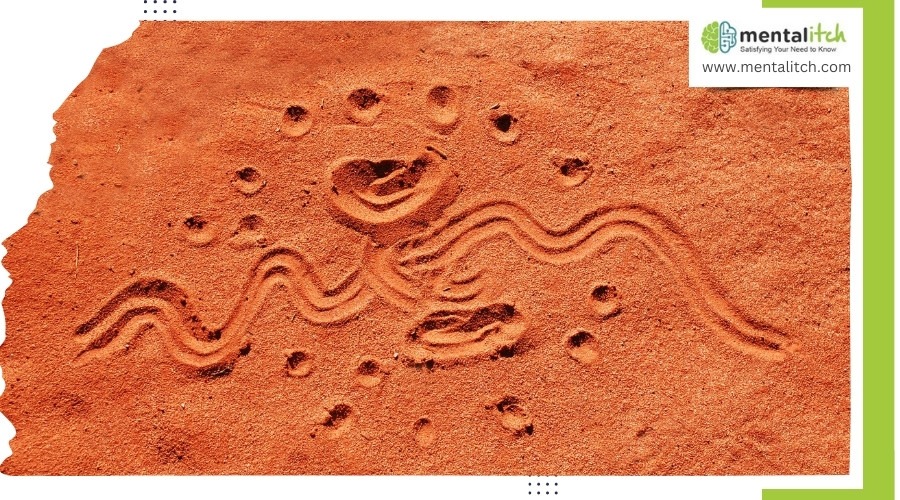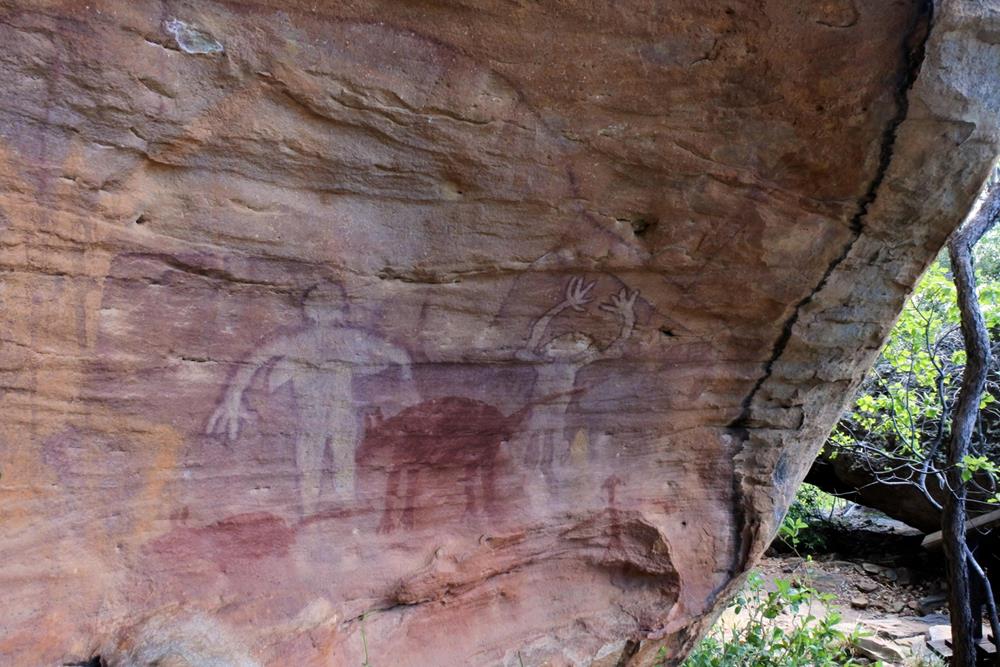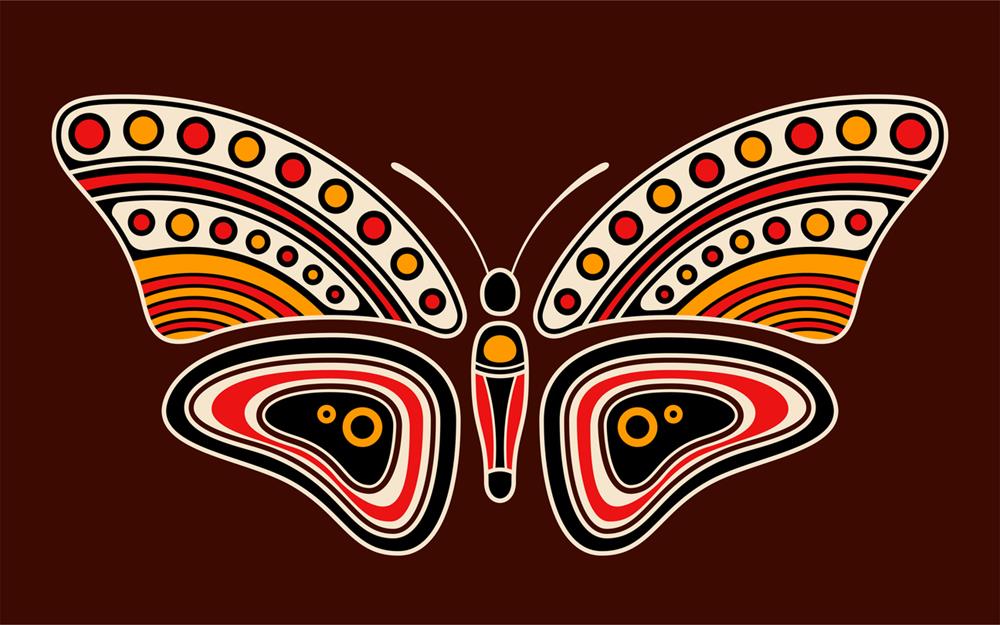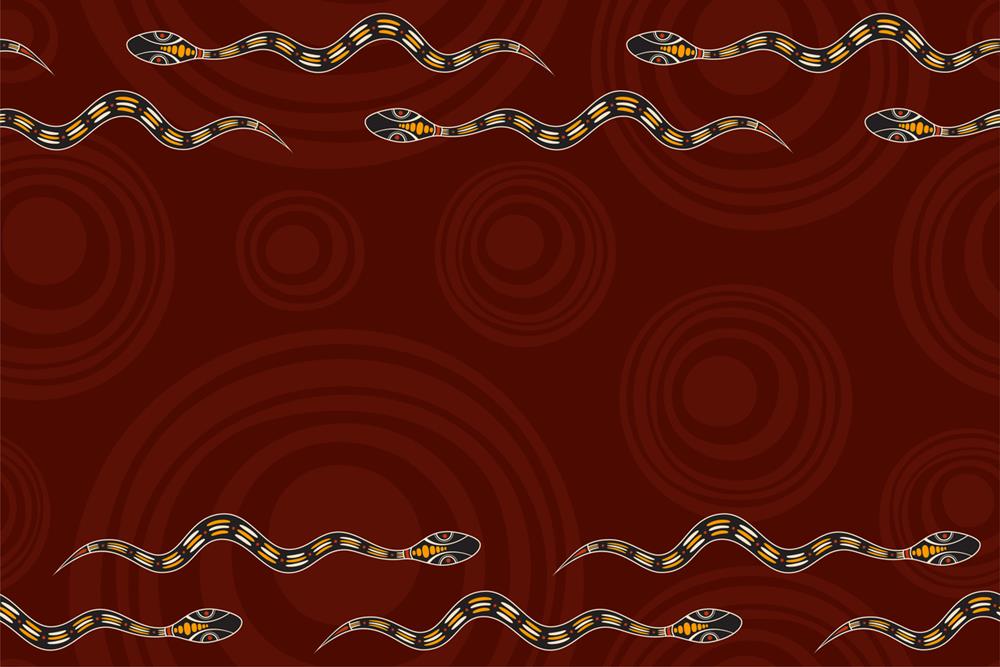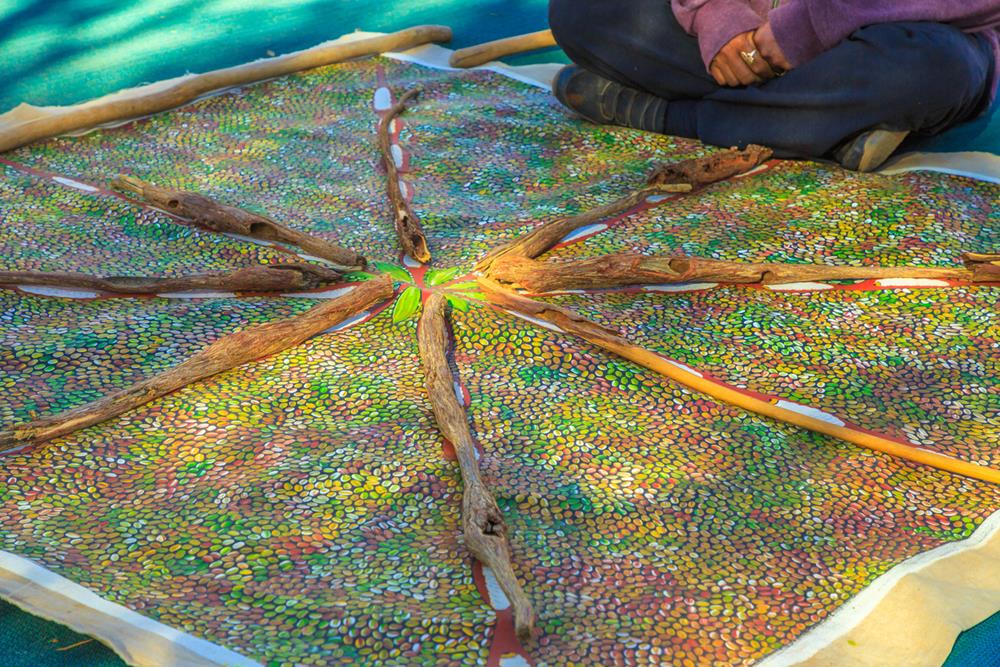Australian Aboriginal art, a window into the soul of the world’s oldest continuous culture, invites us to understand a rich heritage that spans thousands of years. This art form, deeply intertwined with the land and the spiritual beliefs of Australia’s Indigenous peoples, offers more than just visual appeal. Through varied styles and mediums, it narrates stories of creation, identity, and connection to country.
In this article, we will focus on the history of Aboriginal Art, tracing its origins from ancient rock paintings to contemporary canvases that continue to enchant the global art community. We aim to offer insights into the diverse styles that have evolved over millennia, each telling its own unique story.
The Origins of Australian Aboriginal Art
The origins of Australian Aboriginal art trace back to ancient times, with evidence suggesting it is one of the oldest continuous art traditions in the world. This art form’s beginnings are intertwined with the very essence of Aboriginal culture, deeply rooted in the Dreamtime – a period that narrates the creation of the world, its landscapes, and its inhabitants by ancestral beings.
Archaeological discoveries across Australia have uncovered a wealth of artifacts, such as ochre paintings, rock carvings, and ceremonial objects, some dating back more than 60,000 years. These ancient works, found in locations like the Kimberley region of Western Australia and the Olary province of South Australia, depict animals, human figures, and intricate patterns. They serve not only as art but as a form of communication and a repository for cultural knowledge and law.
One of the most remarkable early findings is the rock art in Kakadu National Park, which dates back over 20,000 years. This site features detailed paintings of animals and human figures, showcasing the deep connection between Aboriginal people and their environment. Another significant site is the Burrup Peninsula, home to one of the world’s largest collections of petroglyphs (rock carvings), with some estimated to be up to 40,000 years old.
Australian Aboriginal Art from the Arnhem Land
Arnhem Land, in the Northern Territory of Australia, has been a center for Indigenous culture and art for thousands of years. The art from this region is known for its distinctive use of natural ochres on bark, wood carvings, and ceremonial objects. These artworks are deeply connected to the Dreaming, ancestral stories that are central to Indigenous Australian cultures.
In the early 20th century, the work of Arnhem Land artists remained relatively unknown outside their communities. However, this changed in the mid-20th century when the efforts of missionaries, anthropologists, and art collectors helped bring Aboriginal art to a wider audience. One of the first significant events in this process was the inclusion of Aboriginal artworks in the 1948 Arnhem Land Expedition, which brought international attention to the art and culture of the region.
During the 1950s and 1960s, artists such as Yirawala, Mawalan Marika, and Narritjin Maymuru played a crucial role in showcasing the richness of Arnhem Land’s Art. Yirawala, known as the “Picasso of Arnhem Land,” was particularly influential in introducing the intricate cross-hatching technique (rarrk) and Dreaming stories to wider audiences. His work and advocacy led to greater appreciation and understanding of Indigenous Art and its creators.
In 1972, the establishment of the Aboriginal Arts Board of the Australia Council for the Arts provided further support for Indigenous artists, including those from Arnhem Land. This organization helped facilitate the marketing and sale of Aboriginal Art, which, in turn, generated income for Indigenous communities and raised the profile of Aboriginal artists.
One of the landmark moments for Arnhem Land art in the late 20th century was the founding of the Yirrkala Church Panels in 1963. Created by artists from the Yolngu people, these panels were a powerful assertion of Indigenous rights and identity, blending traditional motifs with Christian themes. The panels not only served as a significant cultural statement but also as a catalyst for the Indigenous land rights movement in Australia.
Australian Aboriginal Art in the 1980s and 1990s
The 1980s and 1990s were dynamic decades for Australian Aboriginal Art, witnessing an unprecedented surge in both creativity and recognition. This period was a critical shift as Aboriginal artists gained a stronger voice on the international stage, transforming the perception of Indigenous Art from ethnographic curiosity to a vital part of the contemporary art world.
A key event in the early 1980s was the establishment of the National Gallery of Australia’s Aboriginal Arts Board. This move significantly boosted the visibility and accessibility of Indigenous Art. Prominent figures such as Rover Thomas and Emily Kame Kngwarreye emerged during this time, breaking new ground with their innovative approaches to traditional themes and storytelling.
Rover Thomas, from the Kimberley region in Western Australia, played a pivotal role in the development of the East Kimberley art movement. His work, characterized by bold colors and abstract landscapes, depicted stories from the Dreamtime as well as contemporary narratives, resonating with audiences both in Australia and internationally. In 1990, Thomas became one of the first Indigenous artists to represent Australia at the Venice Biennale, a testament to his significant impact on the art world.
The late 1980s also witnessed the meteoric rise of Emily Kame Kngwarreye, from the Utopia community in the Northern Territory. Despite only starting to paint on canvas in her late 70s, Kngwarreye’s prolific output and distinctive style quickly garnered widespread acclaim. Her work, often compared to abstract expressionism, transcended cultural and artistic boundaries, making her one of the most celebrated Indigenous artists of her time. In 1998, a retrospective exhibition of her work toured Japan, highlighting her international appeal.
The 1990s saw further institutional support for Indigenous artists, with the founding of the Indigenous Australian Art Commercial Code of Conduct aimed at protecting artists’ rights and ensuring fair dealing within the art market. This period also saw the rise of regional art movements and centers, such as the Tiwi Islands, where artists like Kitty Kantilla (Kutuwulumi Purawarrumpatu) gained recognition for their unique and powerful works.
Moreover, the landmark Native Title Act of 1993, recognizing the rights of Aboriginal and Torres Strait Islander peoples to their land, had a profound impact on the art community. It inspired a wave of politically charged artworks, with artists like Gordon Bennett and Tracey Moffatt using their art to address issues of identity, racism, and colonial history. Their work challenged audiences to reconsider Australian history and the ongoing impact of colonization.
21st Century Australian Aboriginal Art
The era of Australian Aboriginal Art in the 21st century has been characterized by a blending of traditional practices with contemporary themes, mediums, and techniques, reflecting the dynamic nature of Indigenous cultures and their ongoing relevance today.
One of the early highlights of this century was the establishment of the National Museum of Australia in Canberra in 2001, which features a significant collection of Aboriginal Art. This institution, among others, has played a crucial role in preserving and promoting Indigenous culture and heritage.
Artists like Shaun Gladwell and Christian Thompson have brought Aboriginal art to new audiences through their participation in international exhibitions and biennales. Thompson, in particular, became the first Aboriginal Australian to be admitted to the University of Oxford as a member of the prestigious British School at Rome in 2010, highlighting the increasing recognition of Indigenous artists on the world stage.
In 2007, the National Indigenous Art Triennial was inaugurated at the National Gallery of Australia, providing a major platform to showcase contemporary Indigenous Art. This event has been instrumental in highlighting the diversity and vibrancy of Indigenous art practices, featuring artists such as Richard Bell, whose provocative works address issues of racial inequality and identity.
The year 2019 marked another significant milestone with the opening of the Tarnanthi Festival at the Art Gallery of South Australia. This annual festival, focusing on contemporary Aboriginal and Torres Strait Islander art, has become a key event in the art calendar, offering artists a space to share their stories, cultures, and perspectives with a wide audience.
Styles of Australian Aboriginal Art
Australian Aboriginal art is a rich and diverse tapestry, reflecting the varied landscapes and stories of Australia’s Indigenous peoples. From ancient rock carvings to vibrant contemporary paintings, this art form encompasses a wide range of styles and mediums. Each piece carries with it the weight of ancestral stories, cultural practices, and a deep connection to the land. In this section, we will look at the different styles of Aboriginal Art, highlighting the unique characteristics and historical contexts that define them.
Dot Paintings
Originating from the Central Desert region, dot paintings are perhaps the most recognized form of Australian Aboriginal Art. This style involves creating images and patterns through the meticulous application of dots using sticks, brushes, or even fingers. The technique was initially used to veil sacred meanings behind the depicted stories, making them accessible only to those with the requisite knowledge. The movement gained momentum in the early 1970s, with artists like Clifford Possum Tjapaltjarri bringing it to the forefront of the art world. Dot paintings often portray Dreamtime stories, landscapes, and animal tracks, serving as both aesthetic expressions and cultural documents.
Bark Paintings
Bark paintings hold a special place in the art traditions of the Arnhem Land region. Crafted by removing a layer of bark from trees and then drying and flattening it to create a canvas, these paintings feature natural pigments to depict ancient stories and clan symbols. This form of art dates back thousands of years and was brought to wider attention in the mid-20th century by artists such as Yirawala and Mawalan Marika. Bark paintings are rich in spiritual and historical narratives, capturing the connection between the people, their ancestors, and the land.
Rock Art
Rock art, encompassing both paintings and engravings on natural rock surfaces, is one of the oldest and most enduring forms of Aboriginal Art. Sites like Kakadu National Park in the Northern Territory and the Burrup Peninsula in Western Australia showcase these ancient artworks, some of which date back more than 20,000 years. This art form provides invaluable insights into the daily lives, spiritual beliefs, and social structures of ancient Aboriginal cultures. It includes depictions of animals, human figures, and mythological creatures, illustrating the deep spiritual connection Indigenous peoples have with their environment.
Sculpture and Weaving
Aboriginal sculpture and weaving practices vary widely across Australia, reflecting the diverse materials available in different regions. From the woven baskets and mats of the Tiwi Islands to the intricate wood carvings and ceremonial poles of the Torres Strait Islands, these art forms are integral to the cultural practices and social fabric of Indigenous communities. Artists like Yvonne Koolmatrie, renowned for her river reed sculptures, have brought contemporary recognition to traditional weaving techniques, showcasing the dynamic nature of Aboriginal Art.
Contemporary Media
In recent years, Aboriginal artists have embraced contemporary media, including photography, film, and digital Art, to express traditional themes and tackle current issues. Artists like Tracey Moffatt and Christian Thompson use photography and video to explore themes of identity, history, and the impact of colonization. Their work challenges stereotypes and opens up new avenues for dialogue and understanding, highlighting the adaptability and resilience of Indigenous cultures.
Interesting Facts About Australian Aboriginal Art
Australian Aboriginal art, with its deep roots and vibrant expressions, is full of intriguing details that extend beyond its rich history and diverse styles. Here are some fascinating facts and statistics that highlight its impact and significance:
- Global Reach: Aboriginal art has captivated audiences worldwide, with exhibitions in major global cities such as New York, London, and Paris. This international interest has helped elevate the profile of Indigenous artists and has made Aboriginal art a significant ambassador for Australian culture on the world stage.
- Economic Impact: The Aboriginal art market is a significant contributor to the Australian economy, with estimates suggesting it generates upwards of AUD 200 million annually. This economic activity provides vital income for Indigenous communities and artists, many of whom live in remote areas.
- Cultural Preservation: Art is a critical vehicle for the preservation and transmission of Indigenous knowledge. Through their work, artists keep alive their languages, stories, rituals, and traditions, passing this cultural heritage down to future generations.
- Recognition and Awards: Indigenous artists have received prestigious awards and honors, both in Australia and internationally. For instance, in 2020, Yolngu artist Dhambit Munuŋgurr won the Telstra National Aboriginal and Torres Strait Islander Art Award (NATSIAA) for her work done exclusively with the color blue, a first in Yolngu art, which traditionally uses natural pigments.
- Innovative Mediums: While traditional mediums like bark painting and dot painting remain popular, many Indigenous artists are also exploring new mediums. Digital art, photography, and installation art are among the contemporary mediums through which Aboriginal artists express their culture and stories today.
- Cultural Tourism: Aboriginal art is a cornerstone of cultural tourism in Australia, attracting visitors keen to learn about the world’s oldest continuous cultures through its visual art forms. Regions known for their art centers, such as the Central Desert and Arnhem Land, draw tourists from around the globe, providing an economic boost to these communities.
- Art Centers: There are over 100 Aboriginal-owned and -operated art centers across Australia. These centers are crucial for supporting artists, providing materials, and ensuring fair trade practices. They serve as community hubs where knowledge and skills are shared among generations.
- Legal Protections: The Australian government has implemented measures to protect Indigenous artists from exploitation and to preserve the authenticity of Aboriginal art. The Indigenous Art Code, established in 2010, promotes ethical trading in Indigenous Art, protecting both the artists and the cultural significance of their work.
- Collaborative Projects: Collaborations between Aboriginal artists and major brands or international artists have brought Indigenous Art into new contexts. These partnerships have helped to raise awareness and appreciation of Aboriginal cultures while also sparking debates about cultural appropriation and the ethics of cross-cultural collaborations.
These facts and statistics underscore the complex and dynamic nature of Australian Aboriginal Art, reflecting its cultural, economic, and artistic significance both within Australia and around the world.
Conclusion
Australian Aboriginal art is a vibrant thread in the fabric of the world’s cultural heritage, offering a window into the rich history, profound spirituality, and resilient creativity of Australia’s First Peoples. From the ancient rock art that adorns remote landscapes to contemporary canvases that command attention in global galleries, this art form spans thousands of years yet remains deeply relevant today. As appreciation for this art form grows, so too does our understanding of its importance in fostering cultural respect and dialogue across communities worldwide.
Additional Suggestions
- The story of Aboriginal art itself is teeming with history, ideas, dreamtime and sacredness.
- Aboriginal tribes use ocher to make colors like yellow, brown and red and charcoal to make black.
- Australian Aboriginal artists invented a unique style of dot painting to obscure secret symbols or iconography from foreigners viewing the art, but can still be understood by those from the Aboriginal community.

